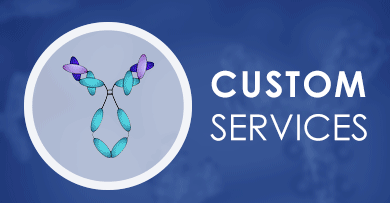 Loading...
Loading...

HLA-DRA
 Loading...
Loading...Anti-HLA-DRA Products
- AbPlus™ Anti-HLA-DRA Magnetic Beads (Bra30) (VS-0424-XY125)
-
- Target: HLA-DRA
- Target Species: Human
- Application: IP, Protein Purification
-
- Antibody Host: Mouse
- Antibody Reactivity: Human
-
- Species Reactivity: Human
- Target: HLA-DRA
- Host Animal: Human
- Application: ELISA, FC, Cell-uptake
- Anti-HLA-DRA Immunohistochemistry Kit (VS-0525-XY3177)
-
- Species Reactivity: Human
- Target: HLA-DRA
- Application: IHC
- Anti-Sheep HLA-DRA Immunohistochemistry Kit (VS-0525-XY3178)
-
- Species Reactivity: Sheep
- Target: HLA-DRA
- Application: IHC
- Anti-Rat HLA-DRA Immunohistochemistry Kit (VS-0525-XY3179)
-
- Species Reactivity: Human, Rat
- Target: HLA-DRA
- Application: IHC
- Anti-Human HLA-DRA Immunohistochemistry Kit (VS-0525-XY3180)
-
- Species Reactivity: Human, Porcine
- Target: HLA-DRA
- Application: IHC
- Anti-Mouse HLA-DRA Immunohistochemistry Kit (VS-0525-XY3181)
-
- Species Reactivity: Human, Mouse, Rat
- Target: HLA-DRA
- Application: IHC
Can't find the products you're looking for? Try to filter in the left sidebar.Filter By Tag
Our customer service representatives are available 24 hours a day, from Monday to Sunday. Contact Us
For Research Use Only. Not For Clinical Use.
Background
Plasma proteins
Membrane
Cell type enhanced (Langerhans cells, monocytes, Macrophages, B-cells, Kupffer cells, Proximal enterocytes)
Group enriched (naive B-cell, intermediate monocyte, memory B-cell, non-classical monocyte, plasmacytoid DC, classical monocyte)
Cell line enhanced (Daudi, HDLM-2, REH, U-266/70, U-698, U-87 MG)
Heterotrimer that consists of an alpha chain HLA-DRA, a beta chain HLA-DRB and a peptide (peptide-MHCII) (PubMed:7477400, PubMed:9354468, PubMed:9782128, PubMed:31619516, PubMed:32668259, PubMed:11080454, PubMed:11163233, PubMed:12244309, PubMed:16079912, PubMed:17583734, PubMed:18697946). Newly synthesized alpha and beta chains forms a heterodimer (MHCII) that associates with the CD74/invariant chain (Ii) in the endoplasmic reticulum (ER). Ii is a trimer composed of three subunits and each subunit interacts with one MHCII dimer, blocking the peptide-binding cleft (PubMed:7479981). As a result, MHCII molecules cannot bind peptides present in the ER (PubMed:7479981). The complex of MHCII and CD74/Ii is transported in vesicles from ER to Golgi to lysosomes, where it encounters antigenic peptides generated via proteolysis of endocytosed antigens. MHCII dimers are dissociated from CD74/Ii by the combined action of proteolysis and HLA-DM (PubMed:25413013, PubMed:23260142, PubMed:21115828). Lysosomal enzymes such as cathepsin, degrade CD74/Ii leaving a 24 amino acid remnant called class II-associated Ii or CLIP. Interacts (via the peptide binding cleft) with CLIP; this interaction inhibits antigen peptide binding before entry in the endosomal compartment (PubMed:9075930, PubMed:7477400). The displacement of CLIP and replacement by a high affinity peptide in lysosomes is performed by HLA-DM heterodimer. HLA-DM catalyzes CLIP dissociation from MHCII, stabilizes empty MHCII and mediates the selection of high affinity peptides (PubMed:23260142, PubMed:11070170, PubMed:9075930). Interacts with HLA-DM heterodimer; this interaction is direct (PubMed:25413013). Interacts (via alpha-1 domain) with TCR (via CDRs) (PubMed:17334368, PubMed:29884618). Interacts (via alpha-2 domain) with CD4 (via Ig-like V-type domain); this interaction increases the affinity of TCR for peptide-MHCII (PubMed:27114505). (Microbial infection) Interacts with Epstein-Barr virus BZLF2/gp42. (Microbial infection) Interacts with Staphylococcus aureus enterotoxin A/entA, enterotoxin B/entB, enterotoxin C1/entC1, enterotoxin D/entD, and enterotoxin H/entH.

